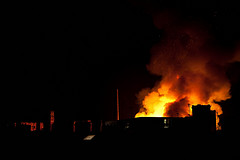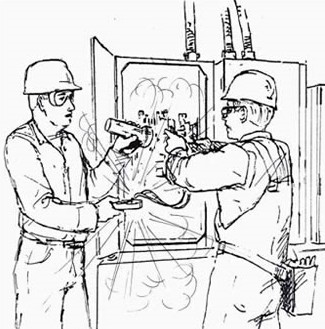
Belgrave Mill burns in 2010 in Oldham, England.
Photo: Gavin Clarke on Flickr
It could be months before investigators know what started an explosion and fire that killed two workers and injured 19 on January 20 at the Babine Mill near Burns Lake, BC. One possible cause is combustible dust explosion, but it’s still way too early to know for sure.
A story in the Burns Lake District News takes an in-depth look at combustible dust, quoting Al Johnson, WorkSafeBC’s regional director, who says it’s too soon to conclude dust is the cause because there would need to be an ignition source for the explosion.
The story references a WorkSafeBC report from December 28, 2011, that says an unacceptably high concentration of pine wood dust was found in the mill basement. But it may be a long time before we know more. Right now, the community is mourning the death of two dads, along with all the other injuries to people and the uncertainty of their jobs.
Other mills taking stock
Crofton Pulp and Paper Mill is reported to be “watching to see what kind of safety lessons can be learned from the Burns Lake fire,” according to the story “Safety a priority at Crofton mill” in the Cowichan Valley News Online HQ.
The story quotes mill manager Rob Belanger, manager of this mill which I once visited when I was a reporter on Vancouver Island in the 1990s. Belanger said their safety practices include a joint health and safety committee, a “multi-level safety program,” and a regular cleaning and maintenance schedule for all machines.

Image from WorkSafeBC Hazard Alert 06-06: Arc ignites sawdust in service panel
Dangers of dust
The Canadian Centre for Occupational Health and Safety says hundreds of workers have been killed or injured by dust explosions in past decades.
“They can seem like harmless substances – sugar, coal, wood dust, flour – however in certain conditions and across many industrial processes, dust from these – and other substances can become the fuel for an explosion,” reads the CCOHS website.
Health Canada uses the term “explosible” in its publication Hazard-Specific Issues – Dust Explosibility in reference to dust that can cause an explosion – to avoid confusion with the term “explosive” which refers to “dusts dispersed as a cloud and ignited.”
This video – from the US Chemical Safety Board – tells the story of 14 workers fatally burned in a series of sugar dust explosions in the US in February 2008.
Also see Arc ignites sawdust in service panel from WorkSafeBC.



An interesting article. Many fail to recognize the dangers of allowing seemingly harmless dust to accumulate.The danger is there, just waiting for ignition.
Great article Susan
Confusion reigns on the huge difference between exceedances of industrial hygiene respiratory levels (milligrams)of airborne dust and high explosive concentrations (grams)of combustible dust. It is disturbing to see the media sensationalize the issue. Especially, when the difference can be in the order of 30,000 depending on moisture content, particle size, chemical composition, etc. This Blog post will help readers understand the difference. “Mystery of Airborne Combustible Dust Concentrations”
http://dustexplosions.blogspot.com/2012/01/mystery-of-airborne-combustible-dust.html
To complicate the issue even further is a recent international article “WorkSafe BC says dust level limits up to employers”
http://www.hazardexonthenet.net/article/47996/WorkSafe-BC-says-dust-level-limits-up-to-employers.aspx?AreaID=2
This is pure science fiction. The B.C Fire Code 2006 (BCFC), a regulation of the Fires Services Act is enforced by the Office of The Fire Commissioner, which has a section on the fire and explosion hazards of Dust Producing Processes in addition to Woodworking Operations.
The 2006 BCFC succeeds the 1998 British Columbia Fire Code. Division B, which contains acceptable solutions (formerly referred to as “technical requirements”) deemed to satisfy the objectives and functional statements listed in Division A. Most of these are carried forward from the 1998 BCFC; http://www.bccodes.ca/bccode_fire.htm
The BCFC references NFPA 664 Prevention of Fires and Explosions in Wood Processing and Woodworking Facilities in the Appendix, where guidelines are found on what constitutes a combustible dust fire and explosion hazardous area http://www.quickscribe.bc.ca/images2/318-03FireCode.pdf
It is the B.C. Office of The Fire Commissioner, who is the senior fire authority in the province with respect to fire safety and prevention that enforces the fire codes not WorkSafeBC. Hope this helps in clearing the confusion that has now spread internationally. http://www.pssg.gov.bc.ca/firecom/index.htm
In contrast,the excerpt below is from section, “G-D1-108-4 Fire safety and prevention,” in the WorkSafeBC Guidelines Workers Compensation Act
“Where WorkSafeBC prevention officers observe what they believe to be a violation of the Fire Services Act or its regulations, prevention officers will notify the local assistant to the Fire Commissioner.
Before notifying the local assistant, the prevention officer should inform the employer of the situation that may be a violation of the Fire Services Act or its regulations (B.C. Fire Code) and that the officer will be advising the Office (Fire Commissioner) about a possible violation. WorkSafeBC prevention officers will not issue an order or exercise another power to directly enforce a statute or regulation of another agency.”
there was another CSB video that also showed a different type of dust explosion that is most likely in this case.
in that one there was a very small initial explosion that shook up dust that was on surfaces. this caused a larger secondary explosion.
this is likely in the burns lake fire as there was noted dust in electrical boxes. and the airborne dust in an earlier report was not near enough to cause an explosion.
full 30 min video
http://www.csb.gov/videoroom/detail.aspx?VID=30